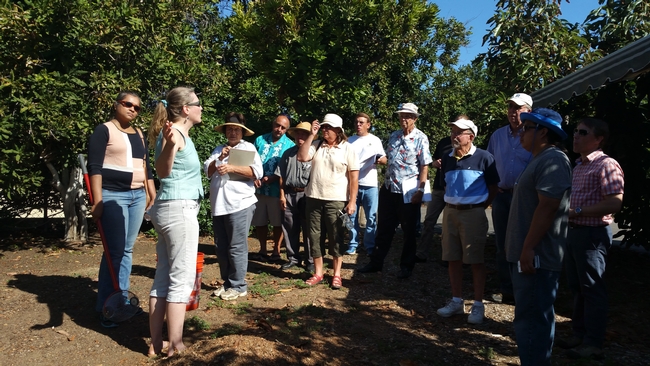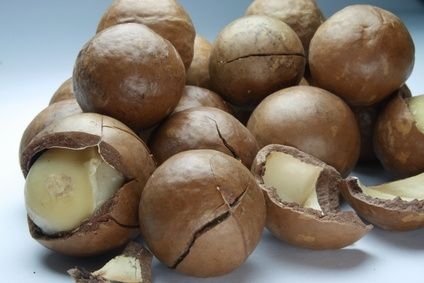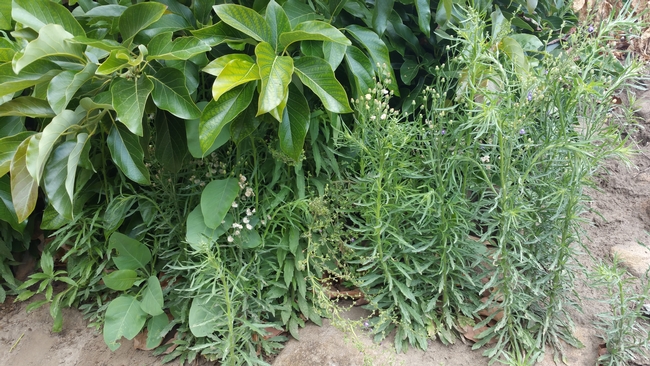
Posts Tagged: tree crops
Disaster Contacts for Growers
|
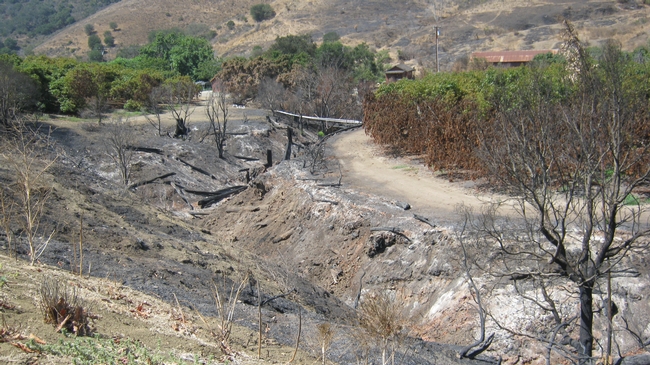
IMG 2037
California Macadamia Society Annual Field Day - Saturday, September 30, 2017
The University of California Cooperative Extension in conjunction with the California Macadamia Society and the Gold Crown Macadamia Association will hold their Annual Field Day on Saturday 30 September 2017, 8:45 A.M. to 1:30 P.M. at the home of Thomas & Bobbi Rastle's, 1115 Valencia Drive, Escondido, California.
We will have classes on topics germane to the macadamia industry, with plenty of opportunities for you to ask questions, both general in nature and about the specifics of your operations. We will also be serving a continental breakfast and a delicious lunch. Please plan to join us for a fun and information filled day.
Directions:
From I-5 & I-15, Exit on 78 east, Right on Broadway in Escondido, Left on Washington Ave, Right on Ash Street (it will become San Pasqual Valley Road), Right on Summit Drive, Right on Valencia Drive to 1115.
From I-15 north, Exit Via Rancho Parkway east (it becomes Bear Valley Parkway), Right on San Pasqual Valley Road, (Note: it is about four miles to San Pasqual Valley Road – Do Not Take San Pasqual Road), Right on Summit Drive, Right on Valencia Drive to 1115.
Cost: $20.00 per person if you pre-pay by 10 September 2017, $25.00 per person after that.
Visit www.macnuts.org/fieldday.htm for a registration form. Mail registration form along with your check to:
California Macadamia Society, P. O. Box 1298, Fallbrook, CA 92088
Questions? (760) 728-8081/Cell 760-580-5516 or RussellFarms@Roadrunner.com
Visit http://www.macnuts.org/fieldday.htm.
Weed Control in Subtropical Tree Crops
Control of weeds has always been a major economic cost in subtropical fruit production because of favorable climate that allows for weed germination and year-round growth. The use of chemical weed control has increased dramatically due to labor costs, equipment costs, product costs and availability, the shift to more narrowly spaced tree rows, and installation of low volume irrigation systems that prohibit the operation of mowing or tillage equipment under the tree canopy area (Futch 2001).
However finding herbicides that are labeled for certain subtropical crops can be a bigger challenge. UC Weed Science has updated the Subtropical Crops herbicides usage chart for California growers (Fig. 1 Attachment below). It also seems that preventive programs are most frequently overlooked as a method of weed control. Preventive programs entail the use of such practices as sanitation, spot spraying, or hand labor to prevent the source of weed infestation (seed and/or vegetative) from widespread dissemination throughout a given area. By removing the undesirable weed species prior to seed development, dissemination by wind or mechanical transport on equipment can be effectively delayed.
Weed control programs will vary from location to location within the state and can even vary within a given site based upon specific conditions such as soil type, variety, method of herbicide application, and the presence of specific weed species.
Before herbicide application, growers should survey the grove and determine the stage of growth and type of weeds for that given location. Many products do not provide control of emerged species, thus requiring the application of more than one product to provide both preemergence and postemergence protection (Futch 2001). Rotation of soil-applied herbicides should also be considered to prevent the buildup of resistant annual and perennial weeds. The resistant species may not be evident initially; however, if the same herbicide and cultural program is maintained, over time their populations may build up until they infest the entire grove and become the dominant weed species (Jordan et al 1992).
Herbicide damage to foliage and fruit has also been noted when herbicides were applied under windy conditions or use of improper equipment allowed the materials to contact areas other than the weeds or soil. Please make sure to follow the label's direction and use caution.
Attached below is a chart listing herbicides registered for avocado, citrus, date, kiwi, fig and pomegranate.
Figure 1. Herbicide Registration on CA Subtropical Crops
Strategizing for Water Cutbacks…Is there a Logical Method?
OK! Let's Strategize. There are four steps for everybody to consider, it doesn't matter if you have a backyard lawn and landscape or if you have 700 acres of avocados.
1. Maintenance: Irrigation System and Cultural Practices
2. Improve Irrigation Scheduling
3. Deficit Irrigation
4. Reduce Irrigated Area
1. Maintenace
a. Irrigation System.
- Fix leaks. Unfortunately, there are almost always leaks for all kinds of reasons. Pickers step on sprinklers, squirrels eat through polytube, branches drop on valves, coyote puppies like to chew….the system should be checked during every irrigation
- Drain the lines. At the beginning of each year every lateral line should be opened in order to drain the fine silt that builds up.
- Maintain or increase the uniformity of irrigation so that each tree or each area gets about the same amount of water. Common problems include different sized sprinklers on the same line or pressure differences in the lines. Where there are elevation changes, every line should have a pressure regulator, they come pre-set to 30 psi. Having all of your lines set up with pressure regulators is the only way you can get an even distribution of water to all of the trees, and it solves the problem of too much pressure at the bottom of the grove and not enough at the top.
- Clean the filters often. You don't have a filter because you think that the district water has already been filtered? Hah! What happens if there is a break in the line in the street and the line fills with dirt during the repairs? All of your sprinklers will soon be filled with dirt.
- Is water flow being reduced at the end of the lateral line? It could be because scaffold roots are growing old enough to pinch off the buried line. The only cure is to replace the line.
-
b. Cultural Management.
- Control the weeds because weeds can use a lot of water.
- Mulch? Mulching is good for increasing biological activity in the soil and reducing stress on the trees, but the mulch will not save a lot of water if you are irrigating often….the large evaporative surface in mulches causes a lot of water to evaporate if the mulch surface is kept wet through frequent irrigation. Mulches are more helpful in reducing water use if the trees are young and a lot of soil is exposed to direct sunlight.
2. Improve the Irrigation Scheduling.
- CIMIS will calculate the amount of water to apply in your grove based on last week’s water evapotranspiration (ET). You can get to CIMIS by using several methods; for avocado growers the best method is to use the irrigation calculator on the www.avocado.org website. If you need further instruction on this, you can call our office and ask for the Avocado Irrigation Calculator Step by Step paper. You need to know the application rater of your mini-sprinklers and the distribution uniformity of your grove’s irrigation system.
- CIMIS tells you how much water to apply, but you need tensiometers, soil probes or shovels to tell you when to water.
- “Smart Controllers” have been used successfully in landscape and we have used one very successfully in an avocado irrigation trial The one we used allowed us to enter the crop coefficient for avocado into the device, and daily ET information would come in via a cell phone connection. When the required ET (multiplied automatically by the crop coefficient) reached the critical level, the irrigation system would come on, and then shut down when the required amount had been applied. Increased precision can be obtained by fine tuning these devices with the irrigation system precipitation (application) rate.
-
3. Deficit Irrigation.
- Deficit irrigation is the practice of applying less water than the ET of the crop or plant materials. Deficit irrigation is useful for conserving water in woody landscape ornamentals and drought tolerant plants where crop yield is not an issue. Water conserved in these areas may be re-allocated to other areas on the farm or landscape.
- There hasn’t been enough research on deficit irrigation of avocado for us to comment. We suspect, however, that deficit irrigation will simply lead to dropped fruit and reduced yield.
- Stumping the avocado tree could be considered a form of deficit irrigation. In this case, the tree should be stumped in the spring, painted with white water-based paint to reflect heat, and the sprinkler can be capped for at least 2 months. As the tree starts to re-grow, some water should be added back, probably about 10-20% of the normal water use of a mature tree.
- Regulated Deficit Irrigation for Citrus is an important method for saving water, and in some cases will reduce puff and crease of the peel. In one orange trial done by Dr. David Goldhammer in the San Joaquin Valley, an application of 25% of ETc from mid-May to Mid July saved about 25% of applied water for the year and reduced crease by 67%, without appreciably reducing yield.
- 4.
- 3. Reduce Irrigated Area.
- Taking trees out of production. Trees that are chronically diseased and do not produce fruit (or the fruit is poor quality) should be taken out of production during this period. Also consider: trees in frosty areas, trees in wind-blown areas, trees near eucalyptus and other large trees that steal the water from the fruit trees.
- Changing crops. You may want to take out those Valencias during this period and replant to something that brings in more money, like seedless, easy-peeling mandarins. The young trees will be using a lot less water.
- Fallow Opportunities. You may decide to do some soil preparation, tillage or cultivation, or even soil solarization of non-irrigated areas.
We have found that this four step process is a logical way to achieve water cutbacks with least impact. It is possible to achieve a ten percent reduction in water by only improving irrigation system uniformity and scheduling procedures. Often, these two measures also result in better crop performance and reduced runoff. Reducing irrigated area or taking areas out of production should be a last resort and a well thought out decision. Plan for the future, hopefully water will be more available in future years.
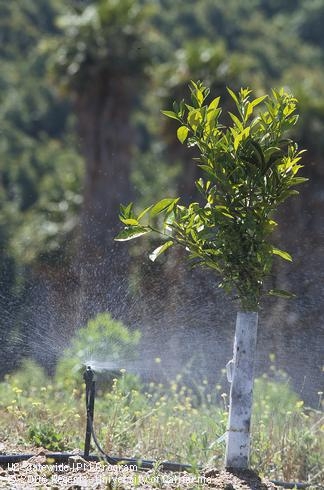
citrus spray
Year Round IPM Guides
About the Year-Round IPM Programs

 The video tour
The video tour
Guided tour of the year-round IPM programs for field, orchard, and vineyard crops. (Detailed outlinewith links to examples)
- Introduction (3 min)
- Prevention (3 min)
- Pest identification (4.5 min)
- Monitoring (5 min)
- Management decisions
(6 min) - Management methods
(6.5 min) - Environmental concerns and summary (8 min)
 Almond
Almond
Guided video tour on how to manage pests using the Almondyear-round IPM program.
- Introduction (2.5 min)
- Dormancy and delayed-dormancy (7 min)
- Bloom to postbloom (7 min)
- Fruit development (8.5 min)
- Harvest and postharvest
(3.5 min) - Pesticide application checklist
(5 min)
A year-round IPM program ![]() is an annual plan of action you can use to implement integrated pest management and evaluate its success.
is an annual plan of action you can use to implement integrated pest management and evaluate its success.
For each season or crop growth stage, these programs highlight the most important pests—insects, mites, weeds, diseases, nematodes, animals—and actions you can take to manage them.
Year-round IPM programs are based on the UC Pest Management Guidelines, the University of California's best information for managing agricultural pests.
A year-round IPM program will help you:
- Eliminate pesticide treatments you don't need
- Minimize risks to water and air
- Protect beneficials and pollinators
A year-round IPM program includes:
- Management activities for key pests at each stage of crop development
- Pointers to key environmental concerns
- Examples of monitoring forms to print and use
- Printable color photo guides to pests and beneficials
- Ways to minimize harm from pesticides
Each year-round IPM program provides links to:
- Pest monitoring instructions and decision thresholds
- Nonchemical and pesticide alternatives for each pest
- Information on pesticide mode of action and impact on beneficials
- A comparison of chemical options and their risks
Natural Resources Conservation Service plans
A year-round IPM program can be the foundation for integrated pest management plans, such as those supported by USDA Natural Resource Conservation Service (NRCS) conservation programs. For more information, contact your local NRCS office.
Figure below. Avocado black streak is a disease that can be managed with irrigation, as described in the Year Round IPM Program for avocado.

black streak

